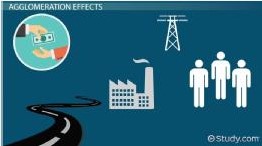The concepts of agglomeration and deglomeration stand as cornerstone topics within economic geography, each playing a pivotal role in shaping the landscapes of urban development and industrial distribution across the globe. These processes influence not only the spatial organization of economic activities but also the dynamics of cities and regions, impacting everything from employment opportunities to environmental sustainability.
Agglomeration refers to the clustering of industries or businesses in a particular area, driven by the benefits of proximity, such as reduced transportation costs, access to skilled labor, and synergies from knowledge sharing. Deglomeration, on the other hand, denotes the dispersal or decentralization of economic activities from crowded urban areas to less dense regions, often triggered by factors like increased costs, congestion, and pollution. Together, these phenomena help explain the evolving patterns of urban and rural economic landscapes.
Understanding the difference between agglomeration and deglomeration requires examining their underlying causes, advantages, and disadvantages. It involves analyzing how these processes affect economies, societies, and environments at both local and global scales. The interplay between agglomeration and deglomeration reveals much about the challenges and opportunities of spatial economic planning and policy-making.

Agglomeration Explained
Core Concepts
Definition
Agglomeration is the phenomenon where businesses and industries cluster together in specific areas. This process allows companies to benefit from being close to each other. Think of it like a shopping mall, where different stores are under one roof to attract more customers.
Types of Agglomeration
Agglomeration comes in various forms, each with its unique features and benefits:
- Industrial Agglomeration: This involves manufacturers and suppliers clustering together. Examples include automobile manufacturing hubs.
- Urban Agglomeration: Cities themselves are examples, where services, businesses, and people come together.
- Technological Agglomeration: Tech companies tend to cluster in regions known as tech hubs, such as Silicon Valley.
Advantages
Economic Benefits
Agglomeration offers numerous economic advantages:
- Reduced Costs: Proximity to suppliers and customers lowers transportation costs.
- Innovation: Clusters promote knowledge sharing and innovation, leading to new products and services.
- Attracting Talent: Regions known for specific industries attract skilled workers, enriching the labor pool.
Social Implications
Agglomeration also has social benefits:
- Job Creation: Clusters can create numerous job opportunities.
- Community Development: As regions develop economically, they can also see improvements in infrastructure, such as schools and hospitals.
- Cultural Exchange: Diverse groups of people coming together can lead to a vibrant cultural scene.
Examples
Industrial Parks
Industrial parks are prime examples of agglomeration. They provide a space where companies from similar sectors can set up operations, benefiting from shared services and infrastructure.
Tech Hubs
Tech hubs like Silicon Valley exemplify technological agglomeration. These areas become magnets for innovation, attracting startups and established companies alike. They are hotbeds for cutting-edge technology and venture capital.
Deglomeration Unpacked
Core Concepts
Definition
Deglomeration is the dispersal of businesses or industries from concentrated areas to wider, often less dense, locations. It’s the opposite of agglomeration. Factors like high costs and congestion in crowded urban areas can drive this process.
Causes of Deglomeration
Several factors contribute to deglomeration:
- Rising Costs: As areas become more developed, costs for land and labor can skyrocket.
- Congestion: Traffic and overcrowding make operations inefficient.
- Technological Advances: Remote work technologies enable companies to operate from anywhere.
Consequences
Economic Impacts
Deglomeration can have mixed economic effects:
- Cost Reduction: Moving to less dense areas can lower operational costs.
- Market Expansion: Companies can tap into new markets and talent pools.
Environmental Effects
Deglomeration can also impact the environment:
- Reduced Urban Congestion: Less density can mean less pollution and traffic.
- Potential for Urban Sprawl: However, spreading out can lead to increased land use and habitat disruption.
Examples
Decline of Manufacturing Cities
Cities once booming with manufacturing activities can experience deglomeration as industries move out in search of cheaper operations and new markets. This shift can leave behind challenges like job losses and economic decline.
Remote Work Trends
The rise of remote work exemplifies deglomeration in the digital space. Companies no longer need to cluster in major cities to attract talent, as employees can work from virtually anywhere, leading to a more distributed workforce.
Comparative Analysis
Economic Factors
Scale Economies vs. Diseconomies
Scale economies are cost advantages businesses gain due to their size, output, or scale of operation, with costs per unit of output decreasing with increasing scale. This concept is crucial in agglomeration, where businesses benefit from being close to each other, sharing resources, and accessing larger markets. For example, companies in industrial parks enjoy shared infrastructure, leading to lower costs and higher competitiveness.
Diseconomies of scale, on the other hand, occur when a business or industry grows so large that the costs per unit increase. It often happens in highly agglomerated areas where the competition for resources (like labor and land) drives up prices. Congestion and overcompetition can also lead to inefficiencies. Deglomeration can be a response to these diseconomies, as businesses seek to maintain optimal sizes by relocating or distributing operations to avoid the high costs associated with over-agglomeration.
Social Factors
Urban Sprawl vs. Community Cohesion
Urban sprawl, a form of deglomeration, refers to the uncontrolled expansion of urban areas into rural lands, leading to spread-out communities with heavy reliance on automobile transportation. It can erode community cohesion, making it harder for people to form close-knit communities due to physical distance and the lack of shared spaces.
Community cohesion thrives in well-planned agglomerated environments where amenities, workplaces, and homes are within easy reach. These areas often enjoy a vibrant community life with shared cultural, recreational, and social spaces, fostering stronger social bonds and a sense of belonging among residents.
Environmental Factors
Pollution vs. Sustainability
Agglomeration can lead to pollution due to high concentrations of industrial activity and traffic congestion, impacting air and water quality and contributing to health issues among the population. Conversely, well-managed agglomeration can lead to more sustainable urban environments through the efficient use of resources, shared public transportation systems, and greener infrastructure.
Deglomeration, aiming to reduce the negative environmental impacts of dense urban centers, can contribute to sustainability if it leads to the adoption of green technologies and practices in less dense areas. However, if not managed properly, it can cause urban sprawl, leading to increased carbon emissions from automobiles and the loss of natural habitats.
Trends and Future Outlook
Technological Advancements
Impact on Agglomeration
Technological advancements have a profound impact on agglomeration. The rise of digital technologies and remote working tools has enabled businesses to operate efficiently without being physically close to each other. This trend could lead to a form of digital agglomeration, where companies cluster in virtual spaces rather than physical locations.
However, the importance of physical proximity for innovation and creativity still favors traditional agglomeration in many industries, especially those reliant on face-to-face interactions and high-tech laboratories. Tech hubs continue to flourish, drawing companies and talent with the allure of community and shared innovation.
Policy and Planning
Urban Development Strategies
Effective urban development strategies are crucial for balancing the benefits of agglomeration with the need to prevent the negative consequences of deglomeration. These strategies can include:
- Zoning Laws: Proper zoning can encourage the development of mixed-use areas that support both living and working spaces, reducing the need for long commutes and promoting community cohesion.
- Infrastructure Investment: Investing in public transportation and green infrastructure can reduce pollution and support sustainable development, making densely populated areas more livable.
- Economic Incentives: Policies that offer incentives for businesses to set up in less developed areas can help distribute economic activities more evenly, preventing the negative impacts of both over-agglomeration and urban sprawl.
The future of urban development lies in creating flexible, resilient communities that can adapt to changing economic, social, and environmental conditions. Balancing agglomeration and deglomeration through thoughtful planning and policy-making will be key to achieving sustainable growth and improving the quality of life for urban and rural populations alike.
Frequently Asked Questions
What drives agglomeration in cities?
Agglomeration in cities is primarily driven by the search for economic efficiency. Businesses cluster together to benefit from reduced transportation costs, access to a larger pool of specialized labor, and the opportunity for innovation and knowledge sharing that proximity enables. This clustering effect can lead to increased productivity and growth, attracting more businesses and workers to the area.
How does deglomeration impact the environment?
Deglomeration can have both positive and negative impacts on the environment. On one hand, it can reduce pollution and alleviate congestion in overcrowded urban areas. On the other hand, it can lead to urban sprawl, putting pressure on rural landscapes, increasing vehicle miles traveled, and potentially leading to loss of habitats and biodiversity.
Can policies influence agglomeration and deglomeration?
Yes, policies can significantly influence both agglomeration and deglomeration. Urban planning and economic policies, such as zoning laws, tax incentives, and infrastructure development, can either encourage the clustering of businesses and industries or support their dispersion. Policies aimed at balancing these processes are crucial for sustainable development and efficient use of resources.
What are the social effects of agglomeration?
The social effects of agglomeration can be quite profound. While agglomeration can lead to job creation, cultural vibrancy, and improved access to services and amenities, it can also result in increased living costs, congestion, and disparities in wealth and opportunity. Managing these social effects requires careful planning and policy intervention.
Conclusion
The intricate dance between agglomeration and deglomeration shapes the economic, social, and environmental fabric of our cities and regions. As we navigate the complexities of urban development and industrial distribution, understanding these processes becomes crucial. They not only inform our approach to spatial economic planning but also highlight the need for policies that foster sustainable growth while mitigating negative impacts.
In conclusion, the balance between agglomeration and deglomeration holds the key to designing resilient, dynamic, and inclusive urban spaces. By acknowledging the benefits and challenges of each process, policymakers, planners, and communities can work together to create environments that promote economic prosperity, social cohesion, and environmental sustainability.

